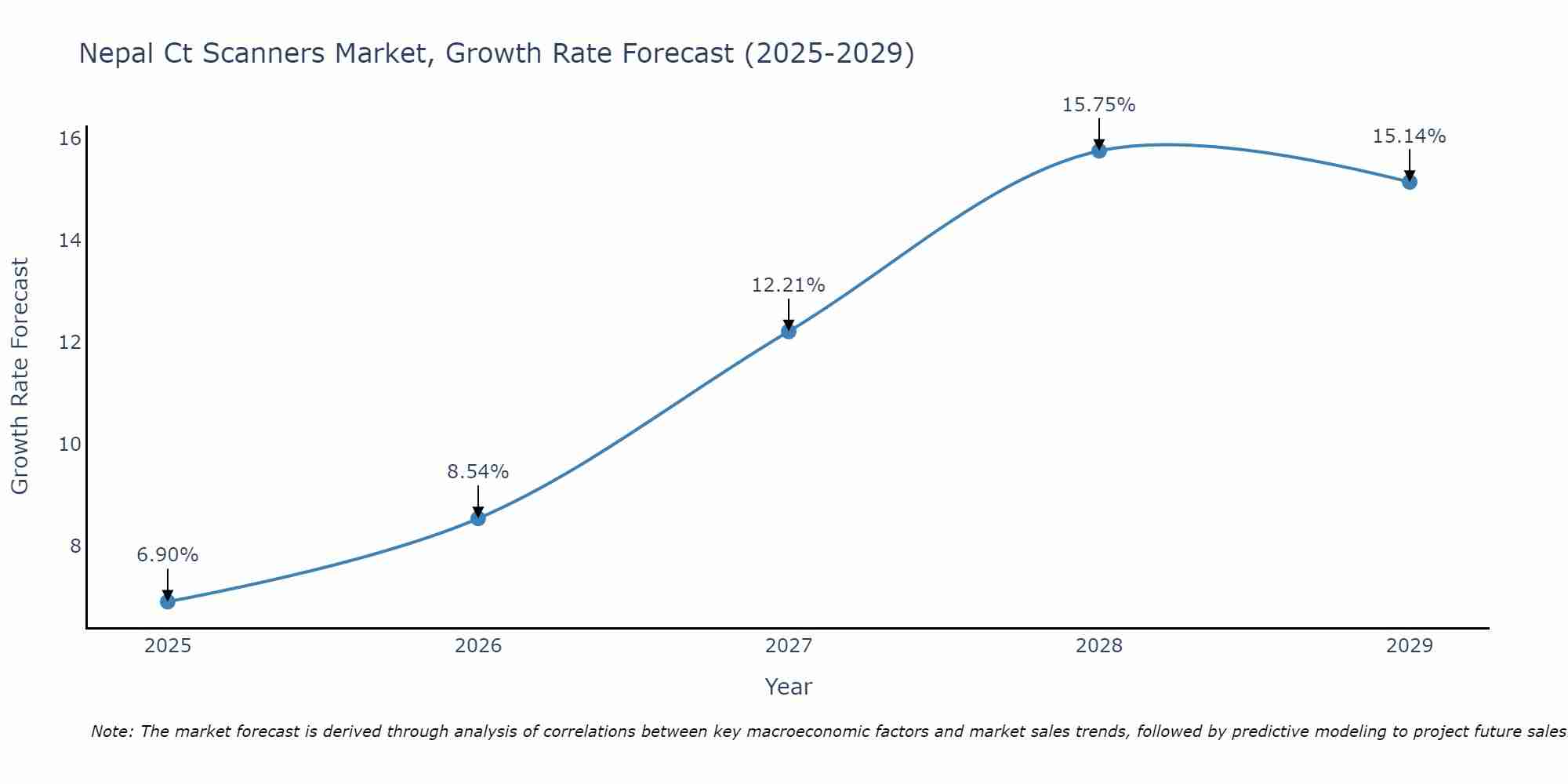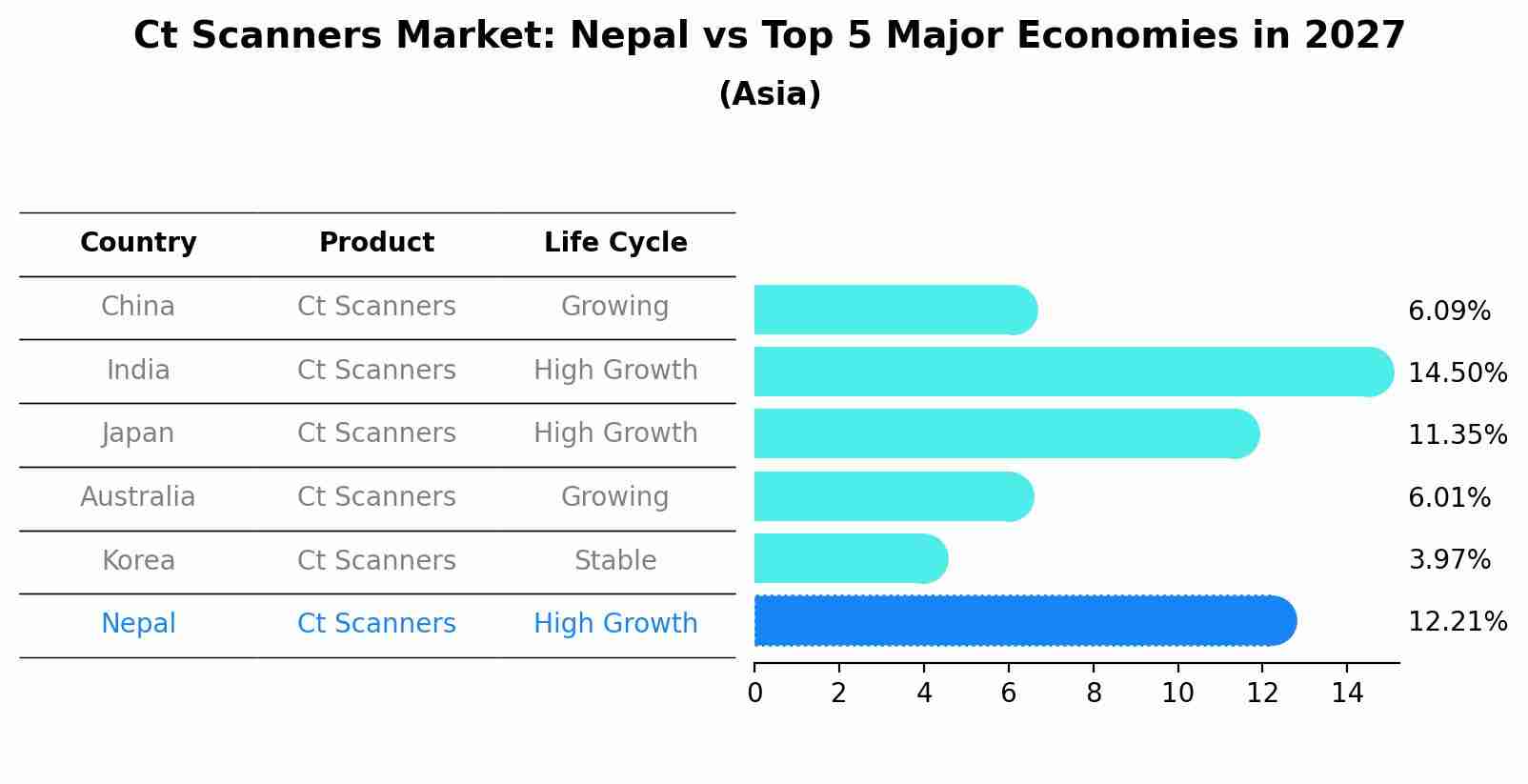Nepal Ct Scanners Market (2025-2031) Outlook | Revenue, Growth, Industry, Forecast, Trends, Share, Analysis, Companies, Size & Value
| Product Code: ETC362796 | Publication Date: Aug 2022 | Updated Date: Aug 2025 | Product Type: Market Research Report | |
| Publisher: 6Wresearch | Author: Sachin Kumar Rai | No. of Pages: 75 | No. of Figures: 35 | No. of Tables: 20 |
Nepal Ct Scanners Market Size Growth Rate
The Nepal Ct Scanners Market is projected to witness mixed growth rate patterns during 2025 to 2029. Starting at 6.90% in 2025, the market peaks at 15.75% in 2028, and settles at 15.14% by 2029.

Ct Scanners Market: Nepal vs Top 5 Major Economies in 2027 (Asia)
Nepal's Ct Scanners market is anticipated to experience a high growth rate of 12.21% by 2027, reflecting trends observed in the largest economy China, followed by India, Japan, Australia and South Korea.

Nepal Ct Scanners Market Synopsis
The Nepal CT scanners market is experiencing steady growth due to increasing investments in healthcare infrastructure and rising demand for advanced diagnostic imaging technologies. The market is driven by factors such as a growing prevalence of chronic diseases, technological advancements in CT scanner systems, and a rising awareness about early disease detection. Key players in the market are focusing on introducing innovative products and expanding their market presence through strategic collaborations and partnerships. Government initiatives aimed at improving healthcare facilities and increasing access to advanced medical equipment are also contributing to the market growth. However, the high cost of CT scanners and limited healthcare budget in Nepal are some of the challenges faced by market players. Overall, the Nepal CT scanners market is poised for continued expansion in the coming years.
Nepal Ct Scanners Market Trends
The Nepal CT scanners market is experiencing a notable trend towards the adoption of advanced technology and increased demand for more accurate and efficient diagnostic imaging. There is a growing preference for CT scanners with higher resolution capabilities, faster scanning speeds, and enhanced software features to improve diagnostic accuracy and patient care. Additionally, there is a shift towards portable and compact CT scanners to cater to the needs of rural and remote areas in Nepal. The market is also witnessing a rise in the installation of AI-powered CT scanners for automated image analysis and improved workflow efficiency. Overall, the Nepal CT scanners market is evolving towards more advanced and user-friendly technologies to meet the growing healthcare demands in the country.
Nepal Ct Scanners Market Challenges
In the Nepal CT scanners market, several challenges are faced, including limited access to advanced healthcare technology in remote areas, inadequate infrastructure for maintenance and servicing of CT scanners, high initial capital investment costs for purchasing and installing CT equipment, and a shortage of trained professionals to operate and interpret CT scan results. Additionally, regulatory challenges and import restrictions on medical devices can hinder the growth of the CT scanners market in Nepal. These challenges collectively impact the adoption and utilization of CT scanners in the country, making it difficult for healthcare facilities to provide timely and accurate diagnostic services to patients in need. Addressing these challenges will be crucial for the development and expansion of the CT scanners market in Nepal.
Nepal Ct Scanners Market Investment Opportunities
The Nepal CT Scanners market presents significant investment opportunities due to the increasing demand for advanced medical imaging technologies in the country. With the growing prevalence of chronic diseases and the need for accurate diagnostic tools, there is a rising demand for CT scanners in Nepal. Investing in this market could be lucrative, especially for companies offering innovative and cost-effective CT scanner solutions tailored to the local healthcare needs. Additionally, government initiatives to improve healthcare infrastructure and services in Nepal further support the growth potential of the CT scanners market. Investors could consider partnerships with local hospitals, clinics, or medical device distributors to capitalize on this expanding market and contribute to improving healthcare access and outcomes in Nepal.
Jordan Agar Market Government Policies
The Nepal government has implemented policies to regulate the importation and operation of CT scanners in the country. These policies include requirements for certification and licensing of CT scanner operators, as well as guidelines for the safe and effective use of the equipment. Additionally, the government has set standards for the quality and performance of CT scanners to ensure reliability and accuracy in medical imaging. Import regulations also play a significant role in controlling the influx of CT scanners into Nepal, with strict compliance measures in place to prevent the entry of substandard or counterfeit products. Overall, these government policies aim to promote the proper use of CT scanners, safeguard patient safety, and maintain the quality of healthcare services in the country.
Nepal Ct Scanners Market Future Outlook
The future outlook for the Nepal CT Scanners market appears promising, with steady growth anticipated in the coming years. Factors such as increasing healthcare infrastructure development, rising prevalence of chronic diseases, and growing awareness about early disease detection are expected to drive the demand for CT scanners in the country. Additionally, advancements in technology leading to improved imaging quality, faster scanning times, and enhanced patient comfort are likely to further fuel market growth. The government`s initiatives to modernize healthcare facilities and improve access to advanced medical equipment will also contribute to the market expansion. Overall, the Nepal CT Scanners market is poised for significant growth opportunities, offering potential for both local and international manufacturers to capitalize on the increasing demand in the region.
Key Highlights of the Report:
- Nepal Ct Scanners Market Outlook
- Market Size of Nepal Ct Scanners Market, 2024
- Forecast of Nepal Ct Scanners Market, 2031
- Historical Data and Forecast of Nepal Ct Scanners Revenues & Volume for the Period 2021 - 2031
- Nepal Ct Scanners Market Trend Evolution
- Nepal Ct Scanners Market Drivers and Challenges
- Nepal Ct Scanners Price Trends
- Nepal Ct Scanners Porter's Five Forces
- Nepal Ct Scanners Industry Life Cycle
- Historical Data and Forecast of Nepal Ct Scanners Market Revenues & Volume By Type for the Period 2021 - 2031
- Historical Data and Forecast of Nepal Ct Scanners Market Revenues & Volume By Stationary CT scanners for the Period 2021 - 2031
- Historical Data and Forecast of Nepal Ct Scanners Market Revenues & Volume By Portable CT scanners for the Period 2021 - 2031
- Historical Data and Forecast of Nepal Ct Scanners Market Revenues & Volume By Device Architecture for the Period 2021 - 2031
- Historical Data and Forecast of Nepal Ct Scanners Market Revenues & Volume By C-arm CT Scanners for the Period 2021 - 2031
- Historical Data and Forecast of Nepal Ct Scanners Market Revenues & Volume By O-arm CT Scanners for the Period 2021 - 2031
- Historical Data and Forecast of Nepal Ct Scanners Market Revenues & Volume By Technology for the Period 2021 - 2031
- Historical Data and Forecast of Nepal Ct Scanners Market Revenues & Volume By High-slice CT for the Period 2021 - 2031
- Historical Data and Forecast of Nepal Ct Scanners Market Revenues & Volume By Mid-slice CT for the Period 2021 - 2031
- Historical Data and Forecast of Nepal Ct Scanners Market Revenues & Volume By Low-slice CT for the Period 2021 - 2031
- Historical Data and Forecast of Nepal Ct Scanners Market Revenues & Volume By Cone-beam CT for the Period 2021 - 2031
- Historical Data and Forecast of Nepal Ct Scanners Market Revenues & Volume By Application for the Period 2021 - 2031
- Historical Data and Forecast of Nepal Ct Scanners Market Revenues & Volume By Human Application for the Period 2021 - 2031
- Historical Data and Forecast of Nepal Ct Scanners Market Revenues & Volume By Diagnostic Applications for the Period 2021 - 2031
- Historical Data and Forecast of Nepal Ct Scanners Market Revenues & Volume By Cardiology Applications for the Period 2021 - 2031
- Historical Data and Forecast of Nepal Ct Scanners Market Revenues & Volume By Oncology Applications for the Period 2021 - 2031
- Historical Data and Forecast of Nepal Ct Scanners Market Revenues & Volume By Neurology Applications for the Period 2021 - 2031
- Historical Data and Forecast of Nepal Ct Scanners Market Revenues & Volume By Intraoperative Applications for the Period 2021 - 2031
- Historical Data and Forecast of Nepal Ct Scanners Market Revenues & Volume By Veterinary Application for the Period 2021 - 2031
- Historical Data and Forecast of Nepal Ct Scanners Market Revenues & Volume By Research Application for the Period 2021 - 2031
- Nepal Ct Scanners Import Export Trade Statistics
- Market Opportunity Assessment By Type
- Market Opportunity Assessment By Device Architecture
- Market Opportunity Assessment By Technology
- Market Opportunity Assessment By Application
- Nepal Ct Scanners Top Companies Market Share
- Nepal Ct Scanners Competitive Benchmarking By Technical and Operational Parameters
- Nepal Ct Scanners Company Profiles
- Nepal Ct Scanners Key Strategic Recommendations
Frequently Asked Questions About the Market Study (FAQs):
- Single User License$ 1,995
- Department License$ 2,400
- Site License$ 3,120
- Global License$ 3,795
Search
Thought Leadership and Analyst Meet
Our Clients
Related Reports
- Canada Oil and Gas Market (2026-2032) | Share, Segmentation, Value, Industry, Trends, Forecast, Analysis, Size & Revenue, Growth, Competitive Landscape, Outlook, Companies
- Germany Breakfast Food Market (2026-2032) | Industry, Share, Growth, Size, Companies, Value, Analysis, Revenue, Trends, Forecast & Outlook
- Australia Briquette Market (2025-2031) | Growth, Size, Revenue, Forecast, Analysis, Trends, Value, Share, Industry & Companies
- Vietnam System Integrator Market (2025-2031) | Size, Companies, Analysis, Industry, Value, Forecast, Growth, Trends, Revenue & Share
- ASEAN and Thailand Brain Health Supplements Market (2025-2031) | Strategy, Consumer Insights, Analysis, Investment Trends, Opportunities, Growth, Size, Share, Industry, Revenue, Segments, Value, Segmentation, Supply, Forecast, Restraints, Outlook, Competition, Drivers, Trends, Demand, Pricing Analysis, Competitive, Strategic Insights, Companies, Challenges
- ASEAN Bearings Market (2025-2031) | Strategy, Consumer Insights, Analysis, Investment Trends, Opportunities, Growth, Size, Share, Industry, Revenue, Segments, Value, Segmentation, Supply, Forecast, Restraints, Outlook, Competition, Drivers, Trends, Demand, Pricing Analysis, Competitive, Strategic Insights, Companies, Challenges
- Europe Flooring Market (2025-2031) | Outlook, Share, Industry, Trends, Forecast, Companies, Revenue, Size, Analysis, Growth & Value
- Saudi Arabia Manlift Market (2025-2031) | Outlook, Size, Growth, Trends, Companies, Industry, Revenue, Value, Share, Forecast & Analysis
- Uganda Excavator, Crane, and Wheel Loaders Market (2025-2031) | Strategy, Consumer Insights, Analysis, Investment Trends, Opportunities, Growth, Size, Share, Industry, Revenue, Segments, Value, Segmentation, Supply, Forecast, Restraints, Outlook, Competition, Drivers, Trends, Demand, Pricing Analysis, Competitive, Strategic Insights, Companies, Challenges
- Rwanda Excavator, Crane, and Wheel Loaders Market (2025-2031) | Strategy, Consumer Insights, Analysis, Investment Trends, Opportunities, Growth, Size, Share, Industry, Revenue, Segments, Value, Segmentation, Supply, Forecast, Restraints, Outlook, Competition, Drivers, Trends, Demand, Pricing Analysis, Competitive, Strategic Insights, Companies, Challenges
Industry Events and Analyst Meet
Whitepaper
- Middle East & Africa Commercial Security Market Click here to view more.
- Middle East & Africa Fire Safety Systems & Equipment Market Click here to view more.
- GCC Drone Market Click here to view more.
- Middle East Lighting Fixture Market Click here to view more.
- GCC Physical & Perimeter Security Market Click here to view more.
6WResearch In News
- Doha a strategic location for EV manufacturing hub: IPA Qatar
- Demand for luxury TVs surging in the GCC, says Samsung
- Empowering Growth: The Thriving Journey of Bangladesh’s Cable Industry
- Demand for luxury TVs surging in the GCC, says Samsung
- Video call with a traditional healer? Once unthinkable, it’s now common in South Africa
- Intelligent Buildings To Smooth GCC’s Path To Net Zero


















